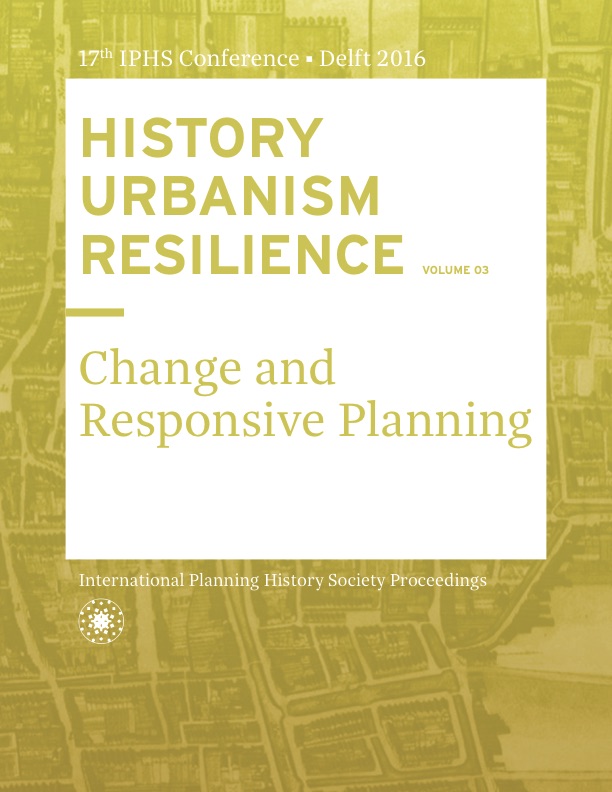Changing realities: Traumatic urbanism as a mode of resilience in intra-war Beirut
DOI:
https://doi.org/10.7480/iphs.2016.3.1836Abstract
In 1975, and in an ambiance of increasing tension, the streets of Beirut served as a stage for a series of violent events and in a matter of days, the sounds of mortar shells and machine guns provided an applied interpretation of the conflicting interests of the different Lebanese and global political players. With few intermissions and a fluctuating intensity, the urban warfare continued for the following 15 years, and resulted in massive destructions and significant movement of citizen’s displacement. Following its instinct to survive and as a reaction to the on-going conflict, Beirut induced new forms of urbanism to maneuver through the imposed reality. The city became divided into two sides, and the once cosmopolitan vibrant city center, developed into an uninhabited green buffer between the rivals. Checkpoints were introduced to re-mark the acquired territories and the citizens’ relation to their public space was redefined by the fields of snipers’ fire. This metamorphosis of the city, together with the irregular and inconclusive nature of the conflict increased Beirut’s immunity to a fatal end. During the 15 years course of the conflict hopes were revived with every ceasefire and few reconstruction plans were developed. This presentation looks into the spatial production in Beirut under the traumatic conditions of the Lebanese civil war. It argues that the continuous process of spatial production which is displayed in the rearrangement of spaces and everyday urban practices is in itself a demonstration of resilience.
References
Abunnasr, M. (2013). The making of Ras Beirut. 1st ed. Amherst, Massachusetts: University of Massachusetts Amherst.
Al Azm, A. (2017). Interview with Amr Al Azm.
Arnaud, J., Assaf, R., Babikian, C., Boudisseau, G., Combes, L., Darles, C., Depaule, J., Douayhi, C., Durand, F., Eddé, C., El-Kak, M., Fattore, M., Hannoyer, J., Khayat, T., Métral, J., Sfeir-Khayat, J., Souaid, M. and Verdeil, E. (2013). Beyrouth, Grand Beyrouth. 1st ed. Beyrouth: Presses de l'Ifpo.
Beyhum, N. (1994). Population Displacement in the Metropolitan District of Beirut: Are the Displacements Over?. Center for Migration Studies special issues, 11(4), pp.11-23.
Bourgey, A. (1985). La guerre et ses conséquences géographiques au Liban. Annales de Géographie, 94(521), pp.1-37.
Collelo, T. (1989). Lebanon, a country study. 3rd ed. Washington, D.C.: Federal Research Division, Library of Congress.
Coward, M. (2002). Community as Heterogeneous Ensemble: Mostar and Multiculturalism. Alternatives: Global, Local, Political, 27(1), pp.29-66.
Coward, M. (2010). Urbicide: The Politics of Urban Destruction By Martin Coward. Global Discourse, 1(2), pp.186-189.
Creative Cities Cairo (2016). Panel 5: Heritage and Urban Culture: George Arbid. [video] Available at: http://www.creativecitiescairo.org/conference/?page_id=7570#George_Arbid [Accessed 12 May 2017].
Davie, M. (1993). A Post-War Urban Geography of Beirut. In: EURAMES. [online] HAL. Available at: https://hal.archives-ouvertes.fr/hal-01083151/document [Accessed 5 Oct. 2016].
Davie, M. (2002). The Emerging Urban Landscape of Lebanon. In: K. Ellis, ed., Lebanon's Second Republic. Prospects for the Twenty-First Century, 1st ed. Florida: University Press of Florida.
Davis, D. (2012). Urban Resilience in Situations of Chronic Violence. [online] Available at: https://cis.mit.edu/sites/default/files/documents/urbanresiliencereport2012.pdf [Accessed 20 Feb. 2017].
Fregonese, S. (2008). City, war and geopolitics: the relations between militia political violence and the built environment of Beirut in the early phases of the Lebanese civil war (1975-1976. Ph.D. Newcastle University.
Malfroy, S. (1998). Urban Tissue and the Idea of Urban Morphogenesis. In: A. Petruccioli, ed., Typological Process and Design Theory, 1st ed. [online] Cambridge: The Aga Khan Program for Islamic Architecture at Harvard University and Massachusetts Institute of Technology. Available at: https://archnet.org/system/publications/contents/4242/original/DPC0446.pdf?1384781997 [Accessed 20 Feb. 2017].
Massard-Guilbaud, G., Platt, H. and Schott, D. (2002). Cities and catastrophes. 1st ed. Frankfurt am Main [etc.]: Lang.
Moudon, A. (1997). Urban morphology as an emerging interdisciplinary field. In: International Seminar on Urban Form. [online] Available at:http://www.urbanform.org/online_unlimited/um199701_3-10.pdf [Accessed 20 Feb. 2017].
Möystad, O. (1998). Morphogenesis of the Beirut Green-Line : Theoretical Approaches Between Architecture and Geography (note). Cahiers de géographie du Québec, 42(117), p.421.
Schmid, H. (2006). Privatized urbanity or a politicized society? Reconstruction in Beirut after the civil war. European Planning Studies, 14(3), pp.365-381.
Vale, L. and Campanella, T. (2005). The resilient city. 1st ed. New York: Oxford University Press.
Verdeil, E., Faour, G., Velut, S., Hamzé, M. and Mermier, F. (2009). Atlas du Liban. 1st ed. Beyrouth, Liban: Presses de l'Ifpo.
Yahya, M. (1998). Reconstituting Space: The Aberration of the Urban in Beirut. In: S. Khalaf and P. Khoury, ed., Recovering Beirut, 1st ed. Leiden: Brill.

